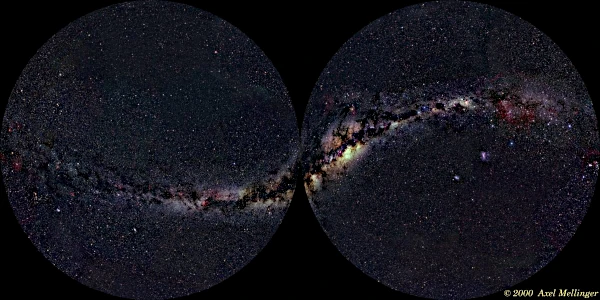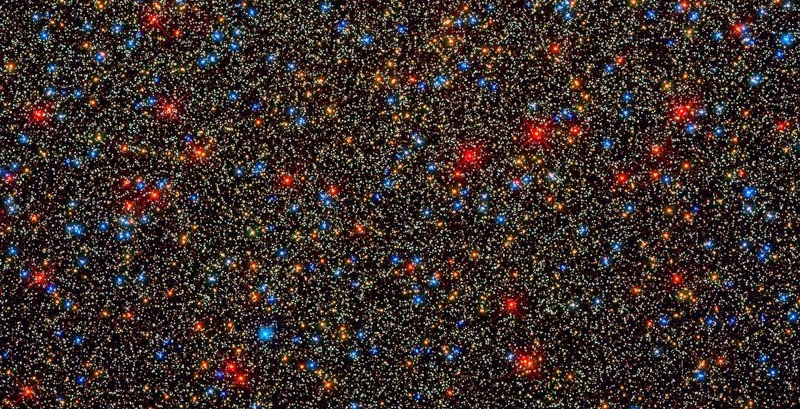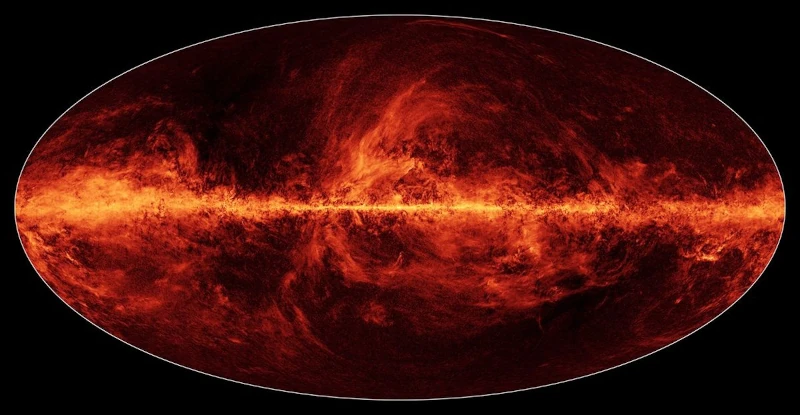
The Milky Way is a typical barred spiral galaxy, containing between 100 and 400 billion stars. Its diameter is about 100,000 light-years, and its average thickness is about 1,000 light-years in the disk. The Sun is located nearly 27,000 light-years from the galactic center, within the Orion Arm.
Infrared and radio observations have revealed a central bar several kiloparsecs long, composed of old stars and a significant reservoir of molecular gas. This type of structure influences the dynamics of the disk and channels gas toward the center.
At the center of the Milky Way lies Sagittarius A*, a supermassive black hole with a mass estimated at \(4.3 \times 10^{6} M_{\odot}\). This estimate comes from analyzing the motion of nearby stars, particularly the star S2, observed for several decades by the team of Andrea Ghez (1965-) and Reinhard Genzel (1952-). Their work earned them the 2020 Nobel Prize in Physics.
The central region, called Sagittarius A, contains intense magnetic fields and dense molecular clouds. X-ray and infrared emissions reveal periodic activity linked to the accretion of matter by the black hole.
The galactic disk is structured into several spiral arms: Perseus, Scutum-Centaurus, Norma, and Sagittarius-Carina. These arms are areas of increased density where massive stars form. Their rotation is not rigid: the angular velocity \(\Omega(r)\) depends on the galactic radius \(r\).
The observed star velocities do not decrease as expected by Isaac Newton's (1643-1727) law: they remain almost constant beyond the bulge. This phenomenon suggests the presence of a halo of dark matter that would dominate the total mass of the galaxy.
The Milky Way interacts gravitationally with its neighbors, particularly the Magellanic Clouds. These interactions cause tidal streams and gas flows toward our disk. In about 4 billion years, a slow collision is expected with the Andromeda galaxy (M31), resulting in a giant elliptical galaxy.

At the heart of the Milky Way lies Sagittarius A*, a supermassive black hole weighing several million solar masses. It influences the dynamics of surrounding stars and gas clouds and generates X-ray and radio emissions, evidence of extreme phenomena in an intense gravitational environment.
The spiral arms are areas where the density of gas and dust is highest. In these regions, new stars are born in clusters, giving rise to famous nebulae like the Orion Nebula. These zones are the galaxy's stellar incubators, illuminating the Milky Way's disk and allowing us to follow the life and death of stars.
Globular clusters are spherical groupings of hundreds of thousands of very old stars located in the galactic halo. They are witnesses to the youth of the Milky Way and preserve the chemical memory of the first generations of stars. These clusters are among the oldest and most fascinating objects observable in our galaxy.

The age of the Milky Way is estimated at about 13.6 billion years, almost as old as the Universe itself. This means our galaxy formed very early, shortly after the Big Bang, when the first clouds of hydrogen and helium cooled enough to allow the formation of stable atoms.
The very first generations of stars, called Population III, formed from this primordial gas. Very massive and short-lived, they quickly exploded as supernovae. These explosions seeded the interstellar medium with heavy elements like carbon, oxygen, and iron, which astrophysicists collectively refer to as "metals."
This chemical enrichment process allowed the birth of younger, more stable stars, as well as rocky planets like Earth. Each generation of stars thus transformed the composition of the galaxy, moving from a nearly pure hydrogen and helium universe to an increasingly diverse environment.
The globular clusters in the galactic halo are direct witnesses to this primitive era. They contain very old stars, sometimes over 12 billion years old. True cosmic archives, they preserve the memory of the chemical composition of the original gas and allow us to reconstruct the first steps in the formation of the Milky Way.
Over time, the matter in the halo condensed under the effect of gravity, forming a vast rotating disk. In this disk, areas of increased density gave rise to the spiral arms, regions where the youngest and brightest stars still form today.
It is in one of these arms that the Sun and its planetary system appeared, about 4.6 billion years ago. Our star is thus the result of a long cycle of transformation and recycling of galactic matter, already enriched by previous generations of stars.
By observing the chemical composition of stars distributed in different regions of the Milky Way, astrophysicists can trace its history. Metal-poor stars dominate the halo, remnants of the distant past, while those in the disk are richer, evidence of continuous recycling of interstellar matter.
Thus, each star carries the chemical signature of the time when it formed. By combining these data with their position in the galaxy, it has been possible to reconstruct the chronology of the formation of the disk and the central bulge. This story, inscribed in the light of the stars, tells more than thirteen billion years of cosmic evolution.
| Event | Approximate age | Description |
|---|---|---|
| Formation of the galactic halo | 13.6 billion years | Condensation of the first gas clouds, formation of Population III stars. |
| Initial chemical enrichment | 13.5-13 billion years | Explosion of supernovae from massive stars, production of the first heavy elements. |
| Formation of globular clusters | 12-13 billion years | Grouping of ancient stars into spherical clusters in the halo. |
| Appearance of the galactic disk | 10-12 billion years | Gradual condensation of matter into a rotating disk, appearance of the first spiral arms. |
| Formation of the Sun and the solar system | 4.6 billion years | Birth of the Sun and its planets in the Orion Arm, from gas enriched by several generations of stars. |
| Continuous formation of spiral arms | Since 4 billion years | Formation of new stars in high-density areas of the disk. |
Sources: NASA ADS, ESO, Nobel Prize in Physics 2020.

The Milky Way is not stationary in the cosmos. It moves within the Local Group, a set of about sixty gravitationally bound galaxies. Its most massive neighbor, the Andromeda galaxy (M31), is gradually approaching us at a speed of about 110 kilometers per second.
This convergence is due to the mutual attraction between the two large spiral galaxies in the group. Precise measurements from the Hubble and Gaia telescopes have confirmed this trajectory, allowing us to predict a future encounter on the scale of a few billion years.
Astrophysicists estimate that the first encounter between the Milky Way and Andromeda will occur in about 4 billion years. On this timescale, stars will not collide, as they are separated by immense distances. However, their gravitational fields will be disrupted, generating massive tidal waves that will stretch the spiral arms.
These deformations will cause local compressions of the interstellar gas, leading to an intense phase of star formation. This type of activity, called a starburst, is well known in galaxy collisions observed by astronomers.
After several passes and partial mergers, the Milky Way and Andromeda will eventually merge into a single galactic entity. Numerical models show that it will take the form of a massive elliptical galaxy, nicknamed Milkomeda. Its core will likely contain a giant black hole resulting from the merger of Sagittarius A* and Andromeda's central black hole.
The spiral morphology will then disappear in favor of a more spherical distribution of stars. Dark matter will continue to maintain the gravitational cohesion of this new structure, which will house several hundred billion stars.
When this merger occurs, the Sun will have already exhausted its hydrogen and transformed into a white dwarf. Its planetary system, devoid of any activity, will slowly drift in the new gravitational field of Milkomeda. Younger stars will then take over, illuminating the new regions resulting from the merger.
Simulations show that some stars will be ejected into intergalactic space due to gravitational interactions. Others will form outer halos and tidal tails, visible remnants of the old galactic disk.
The future history of the Milky Way illustrates the constant evolution of the Universe. Galaxies are born, grow, meet, and transform. In about 7 billion years, the final result will be a stable, elliptical galaxy, more massive and less structured than our current Milky Way.
Even if no human will be there to witness this spectacle, the light of the stars and the gravitational traces of this merger will remain the silent testimony of an inevitable cosmic transformation.